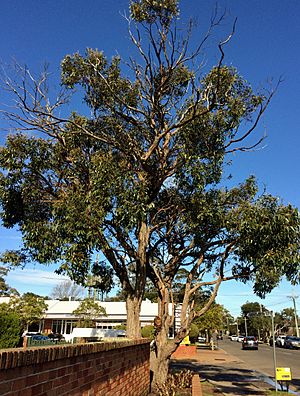Eucalyptus baxteri facts for kids
Quick facts for kids Brown stringybark |
|
|---|---|
 |
|
| Eucalyptus baxteri, Caringbah NSW Australia |
|
| Scientific classification | |
| Genus: |
Eucalyptus
|
| Species: |
baxteri
|
The Brown Stringybark (scientific name: Eucalyptus baxteri) is a medium-sized tree found only in southeastern Australia. It's easy to spot because of its rough, stringy bark that covers its trunk and even its smallest branches. This tree has long, curved adult leaves, greenish-yellow flower buds that grow in small groups, and fruit shaped like a cup or half-sphere.
Contents
What the Brown Stringybark Looks Like
The Brown Stringybark is a tall tree that can grow up to 40 metres (131 ft) high. It has a special woody swelling at its base called a lignotuber. This helps the tree regrow if it's damaged, for example, by a bushfire.
Its bark is grey to brownish and feels rough and stringy. This bark covers the whole tree, from the main trunk all the way to the thinnest branches.
Leaves and Flowers
Young Brown Stringybark plants have glossy, egg-shaped leaves. These leaves are about 25–105 mm (0.98–4.1 in) long and 13–75 mm (0.5–3 in) wide.
As the tree gets older, its leaves change. Adult leaves are usually lance-shaped (like a spearhead) or curved. They can be 60–150 mm (2.4–5.9 in) long and 15–55 mm (0.6–2 in) wide. These leaves have a stalk, called a petiole, that is about 10–29 mm (0.39–1.1 in) long. Both sides of the adult leaves are shiny green.
The flowers grow in small groups, usually with nine to fifteen buds together. These groups grow from the spot where a leaf joins the stem. Each group of buds is on a short stalk, called a peduncle, which is 2–14 mm (0.079–0.55 in) long. The individual flower buds also have tiny stalks, called pedicels, up to 2 mm (0.079 in) long.
When the buds are ready to open, they are green to yellow and shaped like an oval. They are about 5–10 mm (0.20–0.39 in) long and 3–6 mm (0.1–0.2 in) wide. Each bud has a cap, called an operculum, which can be rounded, cone-shaped, or flat and warty. This cap covers the flower parts inside.
The Brown Stringybark mainly flowers from June to January. Its flowers are white.
Fruit
After flowering, the tree produces woody fruit. These fruits are shaped like a cup, a half-sphere, or a flattened sphere. They are about 4–12 mm (0.16–0.47 in) long and 6–18 mm (0.2–0.7 in) wide. Inside the fruit are valves (parts that open) that are usually level with the rim or stick out a little bit.
How it Got its Name
The Brown Stringybark was first officially described in 1867 by a scientist named George Bentham. He gave it a long scientific name: Eucalyptus santalifolia var.? baxteri. This description was published in a book called Flora Australiensis.
Later, in 1926, another scientist named John McConnell Black gave it the shorter name we use today: Eucalyptus baxteri. He published this name in his book, Flora of South Australia.
The second part of its scientific name, baxteri, is a special way to honor someone. It was named after William Baxter, who was a botanist (a plant scientist).
Where the Brown Stringybark Lives
The Brown Stringybark grows in different types of places across southeastern Australia. You can find it in wet forests, woodlands, areas with low shrubs (called heath), and even on sand dunes and rocky headlands along the coast.
It grows in three Australian states:
- In New South Wales, you'll only find it in the very south, starting from the Nadgee Nature Reserve.
- In Victoria, it grows near the coast and also further inland in places like Casterton, Clunes, and the Grampians.
- In South Australia, it's found in the far southeast, including the Fleurieu Peninsula and Kangaroo Island.
Ecology and Wildlife
The Brown Stringybark plays an important role in its environment. The seeds from older trees, especially those over 100 years old, are a vital food source for a special bird.
This bird is the endangered southeastern subspecies of the red-tailed black cockatoo. These cockatoos rely on the seeds of the Brown Stringybark to survive.
Gallery
- Features of the brown stringybark (Eucalyptus baxteri)
See also
 In Spanish: Eucalyptus baxteri para niños
In Spanish: Eucalyptus baxteri para niños






